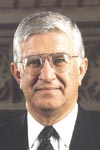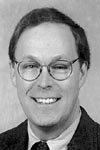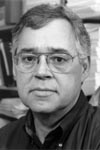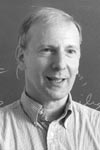National academies elect seven faculty members
By Laurie B. DavisNews Office
The American Academy of Arts and Sciences and the National Academy of Sciences have elected to their memberships President Randel and six members of the University faculty.
Randel and professors Douglas Diamond, Robert Rosner and Lucia Rothman-Denes have been elected fellows of the American Academy of Arts and Sciences for 2001.
Frank Richter, Edwin Taylor and Robert Wald are among 72 new members and 15 foreign associates from 10 countries elected to the National Academy of Sciences for 2001.
Founded in 1780, the American Academy of Arts and Sciences is an international learned society composed of the world’s leading scientists, scholars, artists, business people and public leaders. This year, 211 new members were elected.
 President Randel |
In 1968, he became a faculty member in the department of music at Cornell University, where he also began his administrative career. Thereafter he served as department chair, vice provost, associate dean and eventually dean of the College of Arts and Sciences. In 1995, he was named provost of Cornell University. He became President-elect of the University of Chicago Dec. 13, 1999, and began his term of office July 1, 2000.
 Douglas Diamond |
 Robert Rosner |
Rosner is renowned for observational and theoretical analysis of the dynamical activity of stars, accretion disks, galaxies and galactic jets. He was cited by the academy for his contributions to understanding the origin and behavior of the active magnetic fields and X-ray emission regions of the sun.
Rothman-Denes, Professor in Molecular Genetics & Cell Biology, researches the molecular biology of bacterial viruses. Rothman-Denes, who was elected to the academy’s biological sciences class, in the section of biochemistry and molecular biology, discovered novel transcribing activities of a bacterial virus, including an RNA polymerase with novel transcriptional properties.
The American Academy of Arts and Sciences’ main headquarters are in Cambridge, Mass. The University has served as the academy’s Midwest Regional Center since 1979, and another regional center is at the University of California, Irvine. The regional centers sponsor Stated Meetings, which give area members an opportunity to meet and share ideas with other academy members across disciplines and institutions. They also offer greater opportunity for fellows to consider developing academy projects and programs. Workshops are frequently held at the regional centers on themes related to academy projects.
Several projects being carried out under the auspices of the Midwest Center include “The Transition from Paper,” a study of the implications of the increasing use of electronic forms of communication for scholarship. Academy fellow Stephen Berry, the James Franck Distinguished Service Professor in Chemistry, is the principal investigator for the project.
Berry and other scholars are probing how the expansion of electronic communications is altering the collection, dissemination and storage of scholarly information in the physical sciences, specifically in chemistry. Plans are underway to expand the work to include study of the influence of electronic communications on the social sciences and the humanities. The project has produced a volume of essays titled The Transition from Paper: Where Are We Going and How Will We Get There?
The University’s Midwest Regional Center will sponsor “Development of the Human Species and Its Adaptation to the Environment” in July at the House of the Academy in Cambridge, Mass.
The National Academy of Sciences elects members in recognition of their distinguished and continuing achievements in original research. Election to membership in the academy is considered one of the highest honors for a U.S. scientist or engineer. Those elected last month bring the total number of active members to 1,874.
 Frank Richter |
Richter worked from the view that the dynamics of plate motions are probably a variant of normal thermal convection, where motion is driven by the sinking of cold, dense material and the rising of warm, light material. He also has worked on a variety of geochemical topics, including the chemical evolution of seawater, melt segregation and chemical diffusion in molten rock systems, and radioactive age dating techniques.
Richter was elected to the American Academy of Arts and Sciences in 1993. He received the Bowen Award of the American Geophysical Union in 1995 for contributions to geochemistry and the Wollard Award of the Geological Society of America in 1999 for contributions to geology using geophysics.
 Edwin Taylor |
His pioneering investigations using biochemical approaches revealed the structure of cytoskeletal systems in cells. In addition, his biophysical studies elucidated the mechanism by which molecular motors convert chemical energy into mechanical force. This is important for understanding everything from how materials are moved about within the cell to how muscles contract. In 1999, Taylor received the E.B. Wilson Medal, the highest honor awarded by the American Society for Cell Biology. He also is a fellow of the Royal Society of London and a member of the American Academy of Arts and Sciences.
 Robert Wald |
He is the author of a standard graduate text in relativity, General Relativity (1984). He also is the author of Space, Time and Gravity (1977), based on the Arthur H. Compton Lectures he presented in 1976, and Quantum Field Theory in Curved Spacetime and Black Hole Thermodynamics, an advanced monograph for specialists in the field. He is a fellow of the American Physical Society and of the American Academy of Arts and Sciences.
The National Academy of Sciences is a private organization of scientists and engineers dedicated to the furtherance of science and its use for the general welfare.
It was established in 1863 by a congressional act of incorporation, signed by Abraham Lincoln, which calls on the Academy to act as an official adviser to the federal government, upon request, in any matter of science or technology.
![[Chronicle]](/images/small-header.gif)